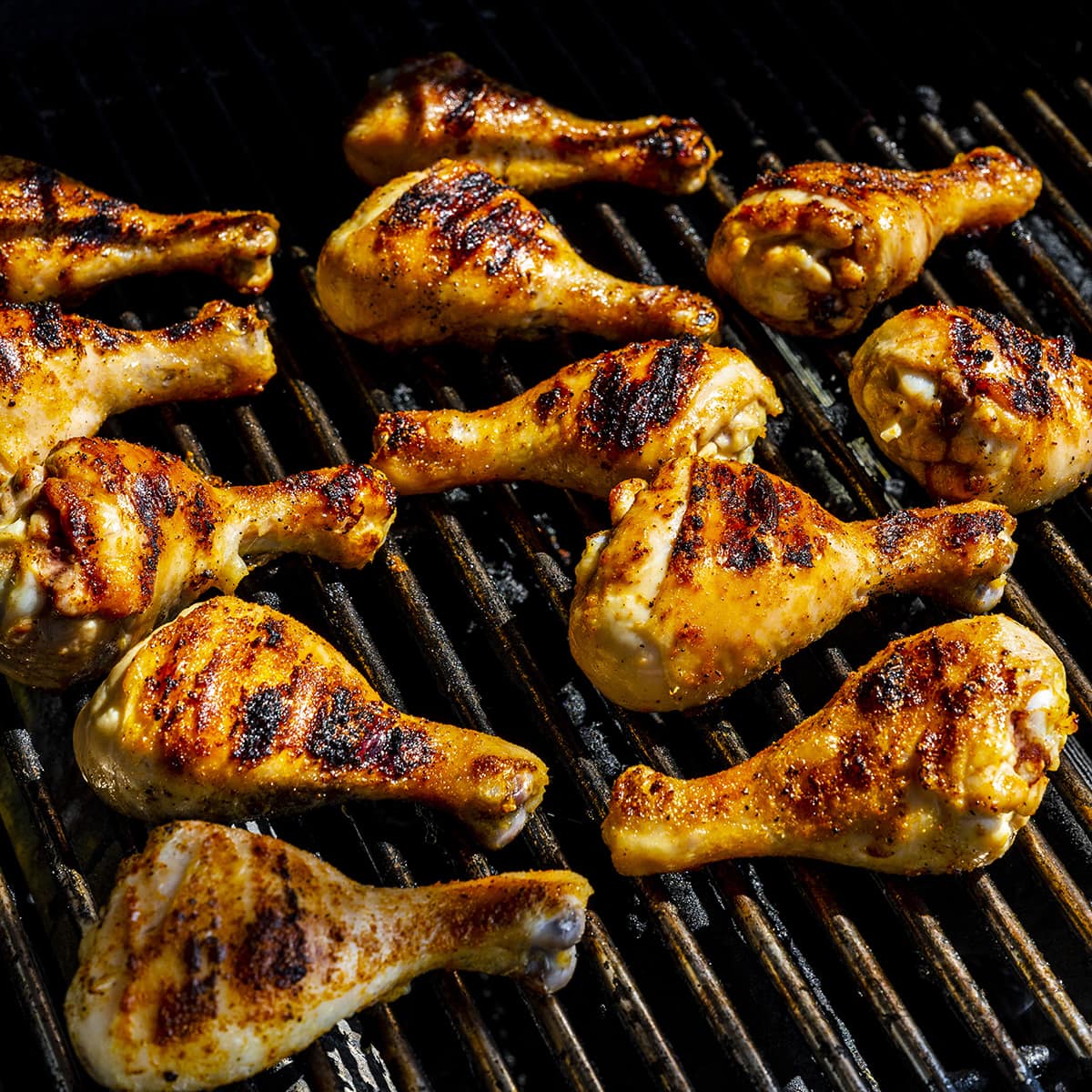The Ultimate Answer: How Long Do You Cook Chicken Legs on the Grill?

Grilling chicken legs can be a delicious and satisfying experience, but knowing exactly how long to cook them can be a bit tricky. In this blog, we’ll explore everything you need to know about grilling chicken legs to perfection. We’ll dive into grilling times, temperatures, techniques, and tips to ensure your chicken legs are juicy, flavorful, and safe to eat. If you’ve ever wondered, “How Long Do You Cook Chicken Legs on the Grill?” this is the ultimate guide for you.
Why Grilled Chicken Legs?
Chicken legs are a popular choice for grilling due to their rich flavor and moist texture. Unlike chicken breasts, which can dry out easily, chicken legs (including thighs and drumsticks) have a higher fat content that keeps them juicy and tender during the grilling process. Plus, the dark meat of chicken legs is more forgiving of temperature fluctuations, making them an ideal choice for grilling.
Choosing the Right Chicken Legs
Before you even fire up the grill, it’s essential to start with high-quality chicken legs. Look for fresh or properly thawed chicken legs that are plump, with smooth, unbroken skin. Organic or free-range chicken often has a richer flavor, though any chicken legs will work as long as they are fresh.
Prepping Your Chicken Legs
- Clean and Pat Dry: Rinse the chicken legs under cold water and pat them dry with paper towels. Removing excess moisture is crucial for achieving crispy skin.
- Marinate or Season: You can marinate your chicken legs for a few hours or overnight to infuse them with flavor. Common marinades include combinations of olive oil, lemon juice, garlic, herbs, and spices. Alternatively, a simple dry rub with salt, pepper, paprika, and other spices can add great flavor.
- Bring to Room Temperature: Before grilling, let the chicken legs sit at room temperature for about 30 minutes. This ensures even cooking.
Setting Up the Grill
The key to perfectly grilled chicken legs is maintaining the right temperature on your grill. Whether you’re using a gas or charcoal grill, here’s how to set it up:
Gas Grill
- Preheat: Preheat the grill to medium-high heat, aiming for a temperature between 350°F to 400°F (175°C to 200°C).
- Create Two Zones: Set up your grill with two zones—one for direct heat and one for indirect heat. This allows you to sear the chicken legs over direct heat and then finish cooking them slowly over indirect heat.
Charcoal Grill
- Light the Charcoal: Light your charcoal and let it burn until it’s covered with white ash.
- Create Heat Zones: Push the coals to one side of the grill to create a hot zone and a cooler zone. The cooler zone will be used for indirect cooking.
How Long Do You Cook Chicken Legs on the Grill?
The million-dollar question—How Long Do You Cook Chicken Legs on the Grill?—depends on a few factors: the size of the legs, the temperature of the grill, and whether you’re grilling with the bone in or out. Here’s a general guideline:
Bone-In Chicken Legs
Cooking Time: 30-40 minutes
- Searing: Start by searing the chicken legs over direct heat for 3-4 minutes per side. This gives the skin a nice crispy texture and locks in the juices.
- Indirect Cooking: Move the chicken legs to the cooler side of the grill (indirect heat) and close the lid. Cook for an additional 25-30 minutes, turning occasionally.
- Check the Internal Temperature: Use a meat thermometer to check the internal temperature. Chicken legs are safe to eat when they reach an internal temperature of 165°F (74°C). However, for more tender and juicy meat, you might want to cook them to 180°F (82°C).
Boneless Chicken Legs
Cooking Time: 20-25 minutes
- Searing: Boneless chicken legs cook faster, so sear them over direct heat for about 2-3 minutes per side.
- Indirect Cooking: Move them to indirect heat and cook for another 15-20 minutes, turning once or twice.
- Check the Internal Temperature: As with bone-in chicken legs, ensure the internal temperature reaches 165°F (74°C).
Grilling Tips for Perfect Chicken Legs
1. Don’t Rush the Process
Cooking chicken legs low and slow ensures they cook evenly without drying out. Avoid the temptation to crank up the heat, as this can result in burnt skin and undercooked meat.
2. Use a Meat Thermometer
A meat thermometer is your best friend when grilling chicken legs. It’s the most accurate way to ensure your chicken is cooked to a safe temperature. Insert the thermometer into the thickest part of the leg without touching the bone.
3. Let Them Rest
After grilling, let the chicken legs rest for 5-10 minutes before serving. This allows the juices to redistribute throughout the meat, making it more flavorful and juicy.
4. Baste for Extra Flavor
Basting the chicken legs with a marinade or sauce during the last 5-10 minutes of cooking can add an extra layer of flavor. Be cautious not to baste too early, as the sugar in many sauces can burn quickly.
5. Grill with the Lid Closed
Grilling with the lid closed helps to retain heat and smoke, which enhances the flavor of the chicken legs. It also promotes even cooking, reducing the chances of flare-ups.
6. Consider Using a Grill Basket
If you’re grilling smaller pieces or have concerns about chicken legs sticking to the grill, a grill basket can be a useful tool. It allows for easy turning and prevents smaller pieces from falling through the grates.
Sauces and Serving Suggestions
Now that you’ve mastered How Long Do You Cook Chicken Legs on the Grill, it’s time to think about sauces and sides.
1. Barbecue Sauce
A classic choice, barbecue sauce adds a smoky, tangy, and slightly sweet flavor to grilled chicken legs. Apply it during the last few minutes of grilling and serve extra on the side.
2. Buffalo Sauce
For those who love a bit of heat, buffalo sauce is a great option. Toss the grilled chicken legs in buffalo sauce after they’re done cooking for a spicy kick.
3. Herb Butter
If you prefer a more subtle flavor, brush the chicken legs with melted herb butter right before serving. A mixture of butter, garlic, parsley, and lemon zest can elevate the taste without overpowering the chicken.
4. Side Dishes
Grilled chicken legs pair well with a variety of side dishes. Consider serving them with grilled vegetables, coleslaw, potato salad, or corn on the cob for a complete meal.
Troubleshooting Common Issues
1. Chicken Legs Sticking to the Grill
If your chicken legs are sticking to the grill, make sure the grates are well-oiled before cooking. Also, ensure the grill is properly preheated.
2. Burnt Skin and Raw Meat
This usually happens when the grill is too hot. If you notice the skin burning before the meat is cooked, move the chicken legs to indirect heat and lower the grill temperature.
3. Dry Chicken Legs
Overcooking is the main cause of dry chicken legs. Always use a meat thermometer to check the internal temperature, and remove the chicken from the grill as soon as it’s done.
4. Uneven Cooking
If some parts of the chicken legs are cooking faster than others, rearrange them on the grill. Thicker parts should be placed over indirect heat, while thinner parts can be cooked over direct heat.
Final Thoughts
Grilling chicken legs can be a rewarding experience when done right. By following the guidelines in this blog, you should now have a clear understanding of How Long Do You Cook Chicken Legs on the Grill and how to achieve perfectly cooked, flavorful chicken legs every time. Remember, the key is to balance searing with slow, even cooking, and to always check the internal temperature before serving.
With a little practice and attention to detail, you’ll be able to master the art of grilling chicken legs, impressing your family and friends with every meal. So fire up the grill, grab those chicken legs, and get ready to enjoy some mouthwatering barbecue!











